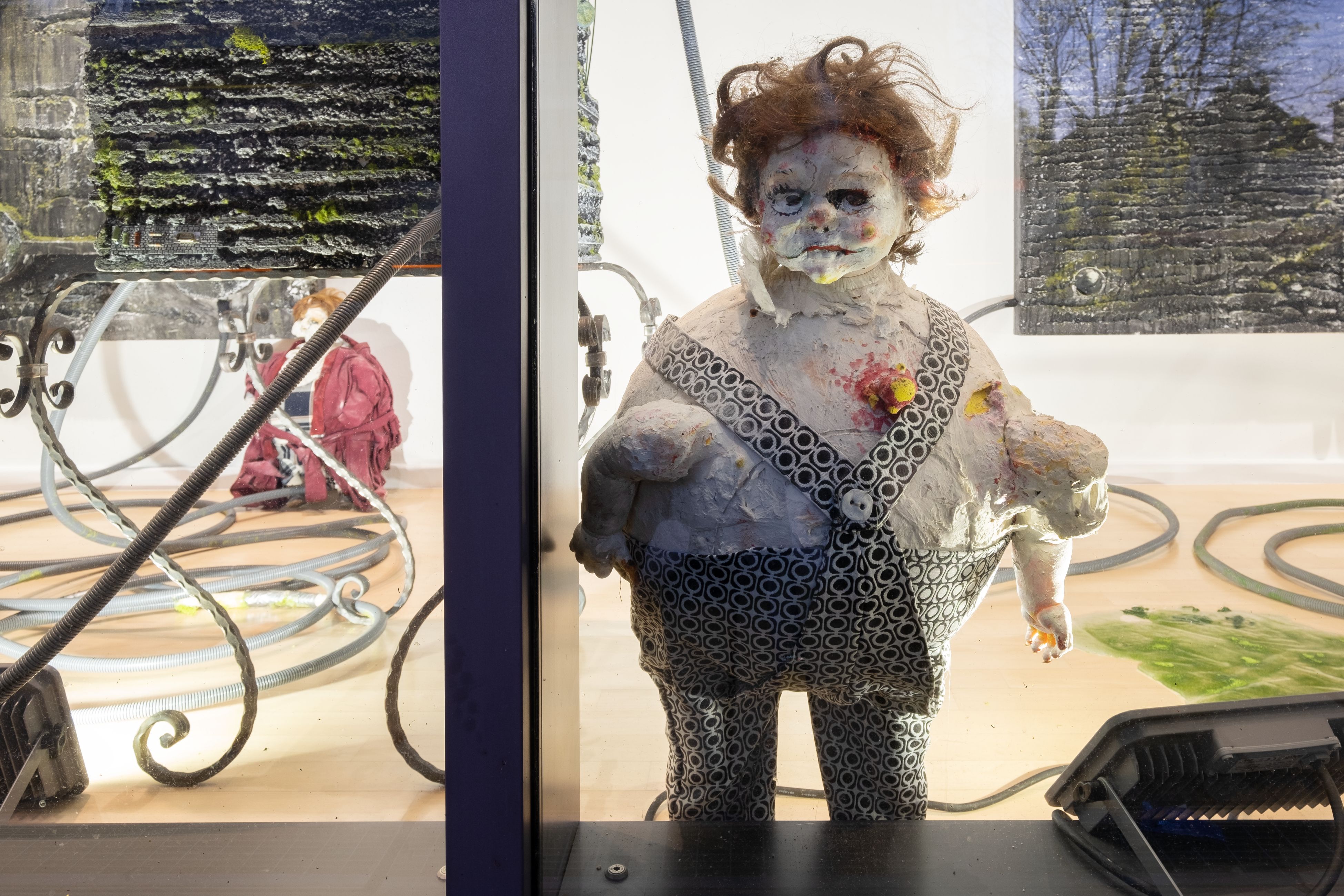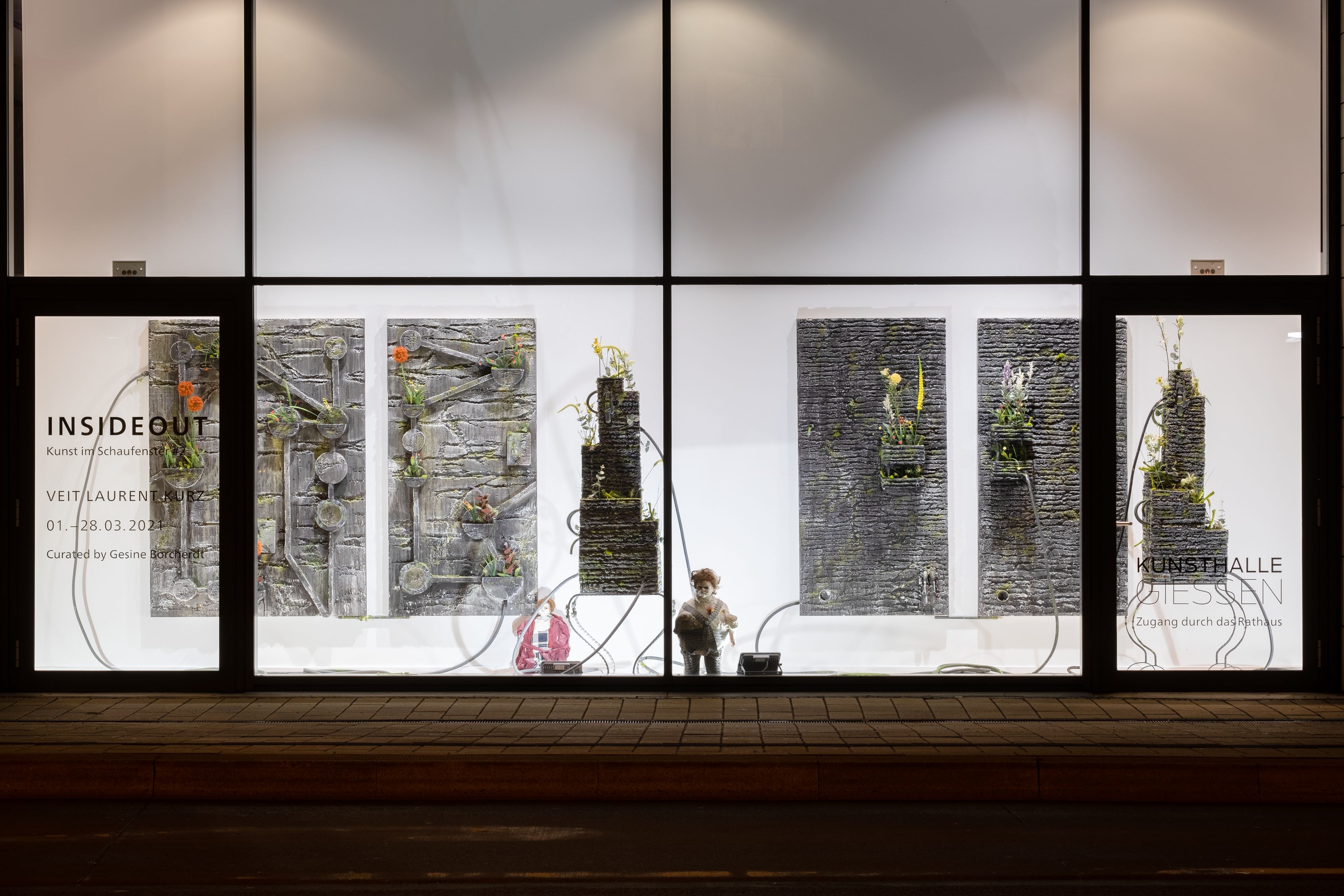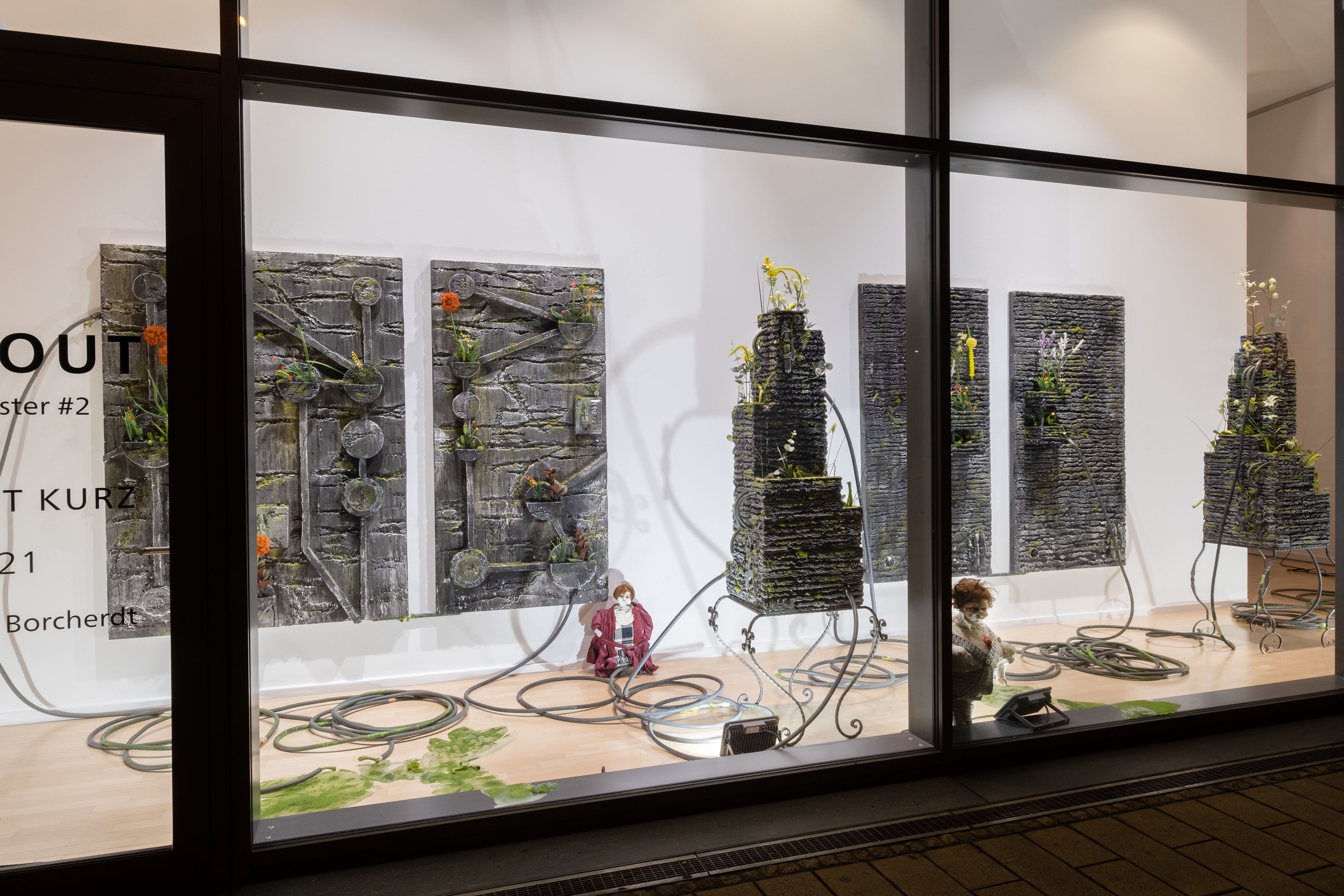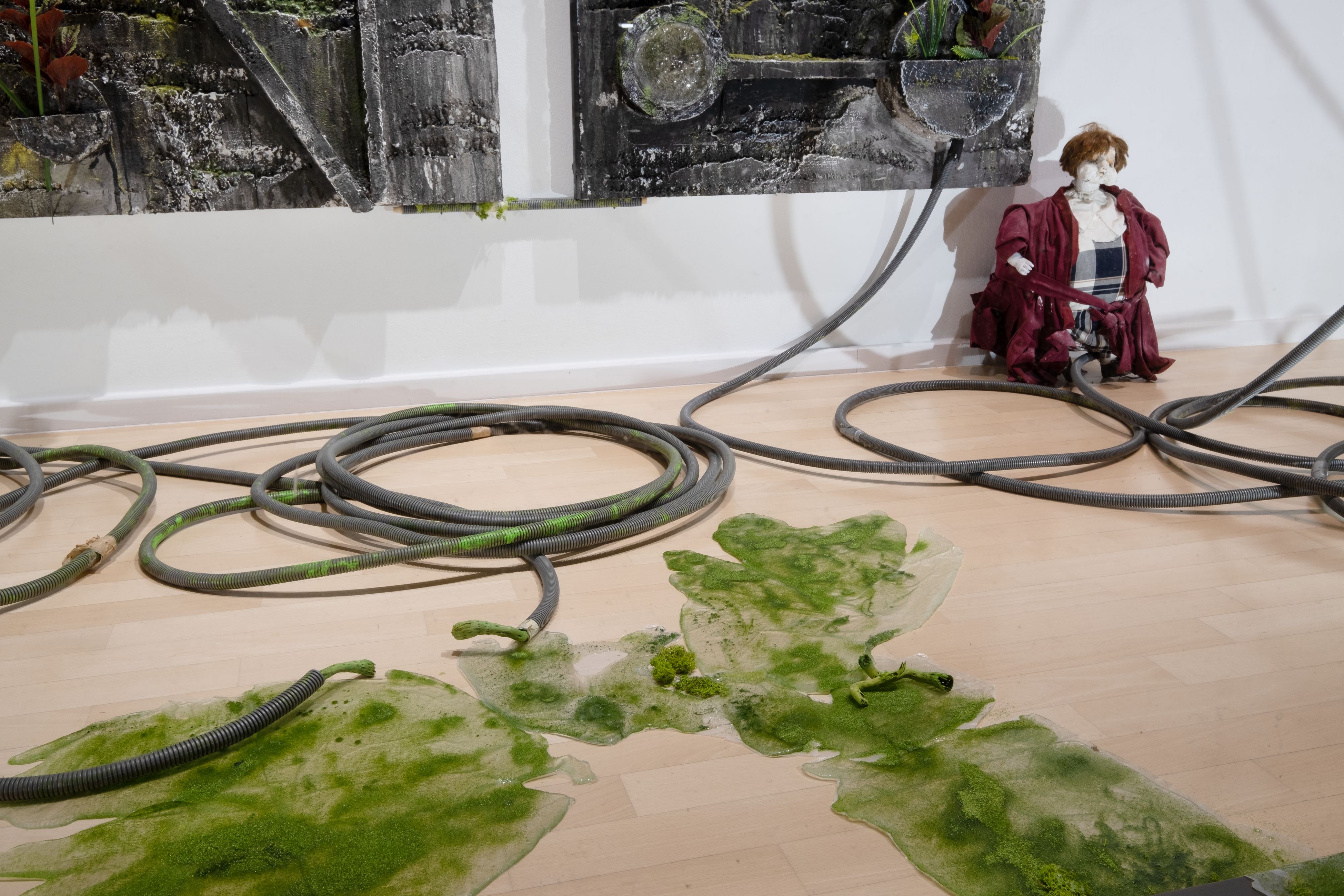INSIDEOUT
#2 Veit Laurent Kurz
1.–28. März | March 2021
Kuratiert von | Curated by Gesine Borcherdt
Wie erspüren wir unsichtbare Gefahr? Wo sitzt sie und was sind ihre Folgen? Das Thema Kontamination beschäftigt Veit Laurent Kurz (geboren 1985 in Erbach, lebt und arbeitet in Berlin) schon seit seiner Kindheit: Beim Spielen im Wald und am Wasser spürt er unsichtbare Geister, die Übelkeit und Halsschmerzen auslösen. Heute sind seine Dilldapps zwergenartige, deformierte Figuren, von denen etwas Toxisches ausgeht. Eingebettet in apokalyptische Szenarien aus Plastikpflanzen, Möbel- und Bauteilen, oft getränkt mit giftgrüner Flüssigkeit wirken sie wie Untote, von denen etwas Märchenhaftes ausgeht – und die ganze Räume in den Abgrund reißen.
Für INSIDEOUT im Schaufenster der Kunsthalle Gießen hat der Künstler eine Installation aus seiner Werkserie Herba 4 aufgebaut, die er immer wieder abwandelt: Bemalte Wandpaneele und turmartige Architekturen aus Styropor, die einen seltsamen, moosig-floralen Bewuchs aufweisen, sind über Schläuche zusammengeschlossen wie eine große Destillationsmaschine. Herba 4 – ein fiktives Elixier, das durch das Rohrsystem hindurch gepumpt wird - fungiert für den Künstler abwechselnd als Kräuterextrakt, als Gift, als Halluzinogen oder gar als fiktiver Impfstoff. Wahlweise gehen also eine tödliche oder eine vitalisierende Wirkung von ihm aus. Wenn Herba 4 wie eine radioaktive, ausgelaufene Flüssigkeit den Boden bedeckt, so gleicht die Szenerie einem Chemielabor, in dem ein Unfall passiert ist – Faszination und Furcht fließen ineinander.
Herba 4 gibt Rätsel auf: Stehen magische oder medizinische Kräfte dahinter? Die paradoxe Verbindung von Technologie und Zauber, von Natur und Maschine, von Organik und Künstlichkeit taucht im Werk von Veit Laurent Kurz immer wieder auf – ebenso wie der Dilldapp, der so etwas wie sein Alter Ego ist. Die folkloristisch-karnevaleske Kreatur hat verschiedene Herkunftsgeschichten. Die eine liegt – wie die Heimat des Künstlers – im Hunsrück. Der Dilldapp kommt auch in der gleichnamigen Geschichte von Clemens Brentano vor, einem Hauptvertreter der deutschen Romantik: Sie erzählt von einem Jungen, der wegen seiner Dummheit von zu Hause fortgejagt wird und fortan bei einem Ungeheuer lebt, das ihm Zaubertricks beibringt. Für den Künstler verkörpert er das Unerklärbare, das im Gegensatz zur Wissenschaft und zu statisch festgelegten Lösungen steht.
How do we perceive invisible danger? Where is it and what are its consequences? Veit Laurent Kurz (born 1985 in Erbach, lives and works in Berlin) has been preoccupied with the subject of contamination since childhood: while playing in the forest and by the water, he sensed invisible spirits that triggered nausea and sore throats. Today, his Dilldapps are dwarf-like, deformed figures from which something toxic emanates. Nestled in apocalyptic scenarios made of plastic plants, furniture and building materials, often soaked in poison-green liquid, they look like the undead that at the same time radiate something fairytale-like – and that plunge entire rooms into the abyss.
For INSIDEOUT in the Kunsthalle Gießen's display window, the artist has erected an installation from his Herba 4 series of works, which he repeatedly modifies: painted wall panels and tower-like structures made of Styrofoam that exhibit a strange, mossy-floral growth are connected to one another via hoses like a large distillation system. Herba 4 – a fictitious elixir that is pumped through the system of pipes – functions for the artist interchangeably as a herbal extract, a poison, a hallucinogen or even a fictitious vaccine. Thus, it can have either a lethal or a vitalising effect. When Herba 4 covers the floor like a spilt radioactive liquid, the scene resembles that of a chemical laboratory in which an accident has occurred – fascination and fear converge.
Herba 4 presents a mystery: are magical or medical forces behind it? The paradoxical combination of technology and magic, of nature and machine, of the organic and the artificial appears again and again in the work of Veit Laurent Kurz – as does the Dilldapp, which is something akin to his alter ego. The creature, both folkloric and carnivalesque, has various origin stories. One comes from Hunsrück, the artist's hometown. The Dilldapp also appears in a story of the same name by Clemens Brentano, a leading figure of German Romanticism: it tells of a boy who was chased away from home for being stupid and from then on lived with a monster who taught him magic tricks. To the artist, he embodies the inexplicable, that which stands in opposition to science and statically established solutions.
Veit Laurent Kurz (*1985 in Erbach) lebt und arbeitet in Berlin. Er studierte an der Hochschule für Gestaltung Offenbach und an der Städelschule in Frankfurt. Seine letzten Einzelausstellungen fanden u.a. im Kunstverein Nürnberg (2019) und in der Städtischen Galerie Delmenhorst (2017) statt. Zudem nahm er u.a. an den Gruppenausstellungen DREAM BABY DREAM im Haus Mödrath, Kerpen (2020) sowie Made in Germany Drei im Sprengel Museum und der Kestner Gesellschaft Hannover (2017) teil.
Veit Laurent Kurz (*1985 in Erbach) lives and works in Berlin. He studied at the Hochschule für Gestaltung Offenbach and at the Städelschule in Frankfurt. His most recent solo exhibitions were held, among others, at Kunstverein Nürnberg (2019) and Städtische Galerie Delmenhorst (2017). He has also participated in the group exhibitions DREAM BABY DREAM at Haus Mödrath, Kerpen (2020) and Made in Germany Drei at the Sprengel Museum and the Kestner Gesellschaft Hannover (2017), among others.
Gesine Borcherdt ist Kunstjournalistin und Kuratorin und lebt in Berlin. Sie ist Autorin bei der Welt, Welt am Sonntag, BLAU International und AD Germany und war leitende Redakteurin des Kunstmagazins BLAU. Von 2014 bis 2019 war sie als Kuratorin des Kunstraums Capri in Düsseldorf tätig. 2020 kuratierte sie die Ausstellung DREAM BABY DREAM im Haus Mödrath in Kerpen. Derzeit arbeitet sie an einem Interviewbuch mit VALIE EXPORT.
Gesine Borcherdt is an art journalist and curator living in Berlin. She is a writer for Welt, Welt am Sonntag, BLAU International and AD Germany and was senior editor of the art magazine BLAU. She was the curator at the Capri art space in Düsseldorf from 2014–2019. In 2020, she curated the exhibition DREAM BABY DREAM at Haus Mödrath in Kerpen. She is currently working on an interview book with VALIE EXPORT.
Text: Gesine Borcherdt




